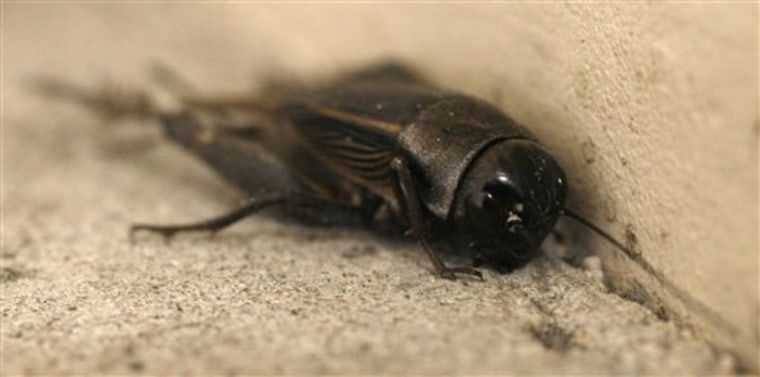They congregate on patios, slip into stairwells and, if they're crunched under foot, oh do they stink. Crickets are here in force, annoying Texans earlier than usual — thanks to the year's wet weather in much of the state.
The problem is so bad at the University of Texas at Austin that school officials are taking the unusual step of darkening the 307-foot-tall bell tower for three nights the next two weekends in hopes of keeping the insects away. The bugs are attracted to lights.
Tower lights will be turned off early Friday evening through Sunday night, and again for three nights the following weekend, Aug. 3-5.
"The tower is one of their primary targets, of course, because we do have the lights on there," said Bill Lucas, associate director of facilities maintenance at UT-Austin. He said the crickets gather atop the tower on its observation deck.
"I don't know if they go up there for the view," he mused.
Crickets seem to like hanging out well above street level at other downtown buildings. Clusters of crickets have been gathering on the ninth-floor balcony outside the Austin office where Lisa Lucero works. She's not amused.
"It's just awful," she said. "They can jump so high. They're irritating and creepy."
Reports of cricket invasions also are coming from counties in the Hill Country and northeast Texas and from Dallas, said Mike Merchant, a Dallas-based entomologist with the Texas Cooperative Extension of the Texas A&M University System.
Typically, field crickets head into cities from their normal rural habitat in early fall for mating flights after rain, once the ground becomes soft enough for egg-laying, Merchant said. This year, after weeks of soaking summer rain, the ground is soft earlier than usual.
The result, Merchant said, is a "cricket rush."
Though some places are reporting more crickets than anyone can remember, others are simply experiencing them sooner.
Lights out
Turning off outdoor lights is the best way to curb the cricket onslaught, he said. Once they land at urban buildings, grackles and pigeons eat some of the crickets.
The insects don't cause any serious damage, but they are an aesthetic pest with their droppings and odor, Merchant said. They can, however, pose a problem for museums because dead crickets in a museum attract other insects that feed on them _ and on the artifacts, he said.
Cleaning up the crickets can become a huge, repetitive chore, according to those who do that nasty job.
"They're a general nuisance. There is the crunching under foot. They die and smell terrible. The smell gets sucked into the air conditioning system," said Lucas, adding that the odor creates an unpleasant work environment in the campus' main building where the tower is located.
University workers began noticing the problem about a week ago and have been gathering cricket information from a campus entomology expert and from the Texas Cooperative Extension.
"They didn't quite say it was of biblical proportions, but it sure seems that way at times."
